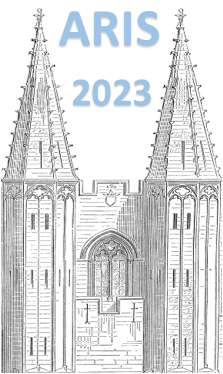Dr
László Stuhl
(Center for Exotic Nuclear Studies, Institute for Basic Science)
At the RIKEN Radioactive Isotope Beam Factory, the spin-isospin response of $^{11}$Li was measured in charge-exchange $(p,n)$ reaction at 182 MeV/nucleon beam energy. There is no available data for isovector spin-flip giant resonances in nuclei with large isospin asymmetry factors, where (N−Z)/A>0.25 [1]. Our work aims to investigate this unexplored region up to (N−Z)/A=0.5.
The charge-exchange $(p,n)$ reactions in inverse kinematics combined with the missing-mass technique are powerful tools to extract the B(GT) strengths of unstable isotopes up to high excitation energies, without Q-value limitation of the β decay [1]. In our previous work on $^{132}$Sn [2], we demonstrated that accurate information about giant resonances can be obtained for unstable nuclei by using this probe. The combined setup [3] of PANDORA low-energy neutron spectrometer [4] and SAMURAI large-acceptance magnetic spectrometer [5] together with a thick liquid hydrogen target allowed us to perform the experiment with high luminosity. The recoil neutrons with kinetic energy of 0.1–10 MeV were identified with PANDORA, while the SAMURAI was used for tagging the decay channels of the reaction residues.
The β decay of $^{11}$Li is complex. The $^{11}$Li β-decay involves the largest number of decay channels ever detected [6] and experimental results have been reported for cases, when the daughter breaks into fragments, and emission of one, two, and three neutrons, α particles and $^{6}$He, tritons, and deuterons has been observed in several β-decay studies [8,9]. However, the B(GT) values were not clearly deduced as these studies were effected by the Q value.
In this talk, the final results of our analysis will be presented. Deduced double differential cross section up to about 40 MeV, including the Gamow-Teller (GT) Giant Resonance region in $^{11}$Li will be reported, as well as the comparison of the obtained B(GT) values with those from β-decay studies. We will discuss the nature of several newly identified decay channels of $^{11}$Be also.
Our observation, that the GT peak occurs below the Isobaric Analog State in $^{11}$Li, will be discussed in connection with the variation of residual spin-isospin interaction in exotic nuclei.
[1] K. Nakayama, et al., Phys. Lett. B 114, 217 (1982).
[2] M. Sasano et al., Phys. Rev. Lett. 107, 202501 (2011).
[3] J. Yasuda et al., Phys. Rev. Lett. 121, 132501 (2018).
[4] L. Stuhl et al., Nucl. Instr. Meth. B 463, 189 (2020).
[5] L. Stuhl et al., Nucl. Instr. Meth. A 866, 164 (2017).
[6] T. Kobayashi, et al., Nucl. Instr. Meth. B 317, 294 (2013).
[7] M. Madurga et al., Nucl. Phys. A 810, 1 (2008).
[8] M.J.G. Borge et al., Nucl. Phys. A 613 199 (1997).
[9] R. Raabe et al., Phys. Rev. Lett. 101, 212501 (2008).
Dr
László Stuhl
(Center for Exotic Nuclear Studies, Institute for Basic Science)
Masaki Sasano
(RIKEN Nishina Center)
Gao Jian
(State Key Laboratory of Nuclear Physics and Technology, School of Physics, Peking University, No. 5 Yiheyuan Road, Haidian district, 100871, Beijing, China)
Y. Hirai
(Department of Physics, Kyushu University)
Prof.
Kentaro Yako
(CNS, University of Tokyo)
T. Wakasa
(Department of Physics, Kyushu University)
DeukSoon AHN
(Center for Exotic Nuclear Studies, KOREA)
Hidetada BABA
(RIKEN Nishina Center)
A. I. Chilug
(Horia Hulubei Nat. Inst. of Phys. and Nucl. Eng.)
Serge Franchoo
(IJCLab)
Y. Fujino
(Department of Physics, Rikkyo University)
Julien Gibelin
(LPC Caen)
K.I. Hahn
(Center for Exotic Nuclear Studies, Institute for Basic Science)
Z. Halász
(ATOMKI, Eo ̈tvo ̈s Lora ́nd Research Network (ELKH), Debrecen, Hungary)
T. Harada
(Department of Physics, Toho University)
Muhsin N. Harakeh
(GSI/KVI)
D. Inomoto
(Department of Physics, Kyushu University)
Tadaaki Isobe
(RIKEN)
H. Kasahara
(Department of Physics, Kyushu University)
D. Kim
(Center for Exotic Nuclear Studies, Institute for Basic Science)
G.G. Kiss
(ATOMKI, Eo ̈tvo ̈s Lora ́nd Research Network (ELKH), Debrecen, Hungary)
T. Kobayashi
(Department of Physics, Tohoku University)
Yosuke Kondo
(Tokyo Institute of Technology)
Zeren Korkulu
(Center for Exotic Nuclear Studies, Institute for Basic Science)
M.
Shumpei KOYAMA
(the University of Tokyo)
Yuki Kubota
(RIKEN)
A. Kurihara
(Dept. of Physics, Tokyo Institute of Technology)
H.N. Liu
(D ́ept. Physique Nucl., CEA, Univ. Paris-Saclay)
M. Matsumoto
(Dept. of Physics, Tokyo Institute of Technology)
S Michimasa
(Center for Nuclear Studies (CNS), The University of Tokyo)
H. Miki
(Dept. of Physics, Tokyo Institute of Technology)
M. Miwa
(Dept. of Physics, Saitama University)
T. Motobayashi
(RIKEN Nishina Center)
Takashi NAKAMURA
(Tokyo Institute of Technology)
M. Nishimura
(RIKEN Nishina Center)
Dr
Hideaki OTSU
(RIKEN Nishina Center)
Valerii Panin
(CEA Saclay)
A.T. Saito
(Dept. of Physics, Tokyo Institute of Technology)
Hideyuki Sakai
(Riken Nishina Center)
Hiromi SATO
(RIKEN Nishina Center)
T. Shimada
(Dept. of Physics, Tokyo Institute of Technology)
Yohei SHIMIZU
(RIKEN Nishina Center)
Susumu Shimoura
(Center for Nuclear Study, the University of Tokyo)
A. Spiridon
(Horia Hulubei Nat. Inst. of Phys. and Nucl. Eng.)
I.C. Stefanescu
(Horia Hulubei Nat. Inst. of Phys. and Nucl. Eng.)
X. Sun
(RIKEN Nishina Center)
Y.L. Sun
(D ́ept. Physique Nucl., CEA, Univ. Paris-Saclay)
Hiroshi Suzuki
(RIKEN Nishina Center, RIKEN)
Y. Togano
(RIKEN Nishina Center)
T. Tomai
(Dept. of Physics, Tokyo Institute of Technology)
L. Trache
(Horia Hulubei Nat. Inst. of Phys. and Nucl. Eng.)
D. Tudor
(Horia Hulubei Nat. Inst. of Phys. and Nucl. Eng.)
T. Uesaka
(RIKEN Nishina Center)
H. Yamada
(Dept. of Physics, Tokyo Institute of Technology)
M. Yasuda
(Dept. of Physics, Tokyo Institute of Technology)
K. Yoneda
(RIKEN Nishina Center)
Koichi YOSHIDA
(RIKEN Nishina Center)
Juzo Zenihiro
(Kyoto University)
N. Zhang
(Institute of Modern Physics, Chinese Acad. of Sci.)

